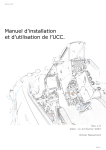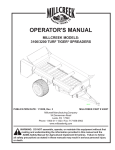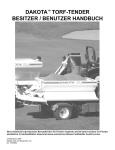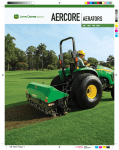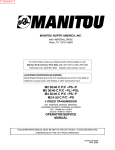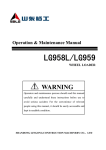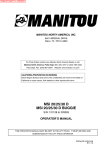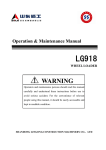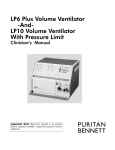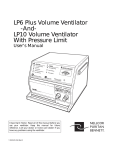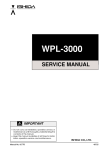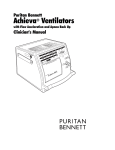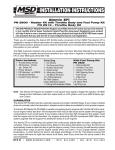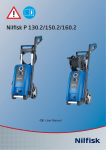Download Turf Tender Service Man 2007.p65 - NH
Transcript
DAKOTA™ TURF TENDER SERVICE MANUAL Copyright 2008 Dakota Peat and Equipment, Inc. p/n need 1 SPECIFICATIONS ITEM Model 410 Dimensions: Height: 54 in. (1.37 m) Length: 144 in. (3.66 m)* Width: 60 in. (1.52 m)* Hopper Capacity (level): 0.85 yd3 (0.65 m3) 2,250 lb (1023 kg) Rear Spinners: Model 411 Model 412 Model 414 Model 420 Model 440 54 in. (1.37 m) 144 in. (3.66 m) 60 in. (1.52 m) 67 in. (1.68 m) 144 in. (3.66 m) 81 in. (2.06 m) 79 in. (2.00 m) 188 in. (4.78 m) 96 in. (2.44 m) 67 in. (1.68 m) 172 in. (4.37 m) 81 in. (2.06 m) 79 in. (2.00 m) 192 in. (4.87 m) 96 in. (2.44 m) 0.85 yd3 (0.65 m3) 2,250 lb (1023 kg) 2 yd3 (1.53 m3) 6,000 lb (2700 kg) 4.2 yd3 (3.21 m3) 12,000 lb (5727 kg) 2 yd3 (1.53 m3) 6,000 lb (2700 kg) 4.2 yd3 (3.2 m3) 12,000 lb (5727 kg) Dual 24 in. (61 cm) Quick Change spinners Sand Spinners (white) Fertilizer Spinners (black) Grass Spinners (green) Spreading Width: Sand/Top Dressing Material Fertilizer: Seed: Top Dressing Speed: 12-40 ft (3.7-12.2 m) 12-40 ft (3.7-12.2 m) 25 ft (2.2 m) Variable to desired application rate 2 to 8 mph (3 to 13.9 kph) Maximum Transport Speed: Empty: 15 mph (24 kph) - Not for highway use. Loaded: Dependent on terrain conditions for safe operation. Hopper Conveyor: Rear Discharge Variable hydraulic speed control Spliced belt 18 in. (45.7 cm) wide belt Front and Rear Discharge Endless belt Metering Gate(s): Rear manual sliding Front & Rear sliding Tires (Trailer-Type Models): 26.5x14x12** Hydraulic System: 3-7 GPM (11.3-26.4 LPM) 2,000-2,500 PSI (138-172 Bar) Max. Shipping Weight (with standard equipment): 920 lb (418 Kg) 1400 lb (636 Kg) Gross Vehicle Weight: 3,170 lb (1441 Kg) 3,170 lb (1441 Kg) 33x20x16.1** 26.5x14x12** 33x16x16.1** 4-11 GPM (15.1-41.64 LPM) 2,500 PSI (172 Bar) Max. 1,825 lb (827) 3,000 lb (1361) 2,840 (1280 Kg) 3,300 lb (1500 Kg) 7,825 lb (3549 Kg) 13,000 lb (5897 Kg) 8,840 lb (4020 Kg) 15,900 lb (7227 Kg) * 410 mounted-type dimensions are: length - 103 in. (2.61 m); width - 54 in. (1.37 m); shipping weight - 780 lb (354 Kg). Trailer-type models with optional power unit, shipping weight - 1240 lb (563 Kg); gross vehicle weight - 3030 lb (1377 Kg). ** 4 ply, turf tread. Maximum Inflation Pressure of 18 PSI (124 kPa) for 26.5 in. tires and 22 PSI (152 kPa) for 33 in. tires. May be adjusted downward by user for specific application and loads. Ground Pressure: Approximately equal to tire’s inflation pressure plus 1 to 2 psi (this is the industry standard method for determination of ground pressure) 2 SPECIFICATIONS TABLE OF CONTENTS SPECIFICATIONS ......................................................................................................................................... 2 GENERAL INFORMATION ........................................................................................................................ 4 MAINTENANCE ........................................................................................................................................... 5 ELECTRIC BRAKES ........................................................................................................................... 7 HOPPER CONVEYOR BELT ............................................................................................................. 9 SIDE CONVEYOR ............................................................................................................................ 11 DUAL SPINNER SPREADING SYSTEM ........................................................................................ 12 ELECTRICAL SYSTEM .................................................................................................................... 13 Electrical Schematics ........................................................................................................................... 17 HYDRAULIC SYSTEM .................................................................................................................... 23 HYDRAULIC ROUTING DIAGRAMS ............................................................................................. 24 STORAGE .................................................................................................................................................... 27 LUBRICATION SCHEDULE ..................................................................................................................... 27 TROUBLESHOOTING ............................................................................................................................... 28 INTRODUCTION ............................................................................................................................. 28 Conveyor ............................................................................................................................................ 28 Spinner ................................................................................................................................................ 28 Hydraulic System ................................................................................................................................. 29 Electrical System ................................................................................................................................. 30 410, 412, & 414 TROUBLESHOOTING FLOWCHARTS ............................................................... 31 Table of Contents 3 GENERAL INFORMATION BEFORE OPERATING Prior to operating the Turf Tender, read and understand the contents of the Operator’s Manual and the Operator’s manual of vehicle either towing or carrying the Turf Tender. Become familiar with all control functions and know how to turn the vehicle off and stop effectively. LABELING AND TERMINOLOGY The Turf Tender and this manual use the following terms and symbols to bring attention to the presence of hazards of various risk levels and important information concerning the use and maintenance of the Turf Tender. WARNING: Indicates presence of a hazard which can cause severe personal injury, death, or substantial property damage if ignored. CAUTION: Indicates presence of a hazard which will or can cause minor personal injury or property damage if ignored. NOTE: Indicates supplementary information worthy of particular attention relating to installation, operation, or maintenance of the Turf Tender but is not related to a hazardous condition. Be sure to follow all instructions and related precautions as they are meant for your safety and protection. Use only the correct replacement parts and fasteners. Right and left-hand sides are determined by facing in the direction of forward travel. AUTHORIZED MAINTENANCE NOTE: For mounted-type Turf Tenders, follow the tire inflation guidelines found in the vehicle’s Operator’s Manual or on the sidewall of the tire. RELIEVE HYDRAULIC PRESSURE Before disconnecting or performing any work on the hydraulic system, all pressure in the system must be relieved by turning all Turf Tender control switches to their OFF position, placing the hydraulic supply valve in the float position, and stopping the engine of the vehicle. Residual hydraulic pressure may still be present, so care must be taken. Make sure parts of the Turf Tender actuated by hydraulic pressure are supported or otherwise restrained to prevent movement prior to relieving hydraulic pressure. Failure to do so could result in damage, injury or even death. KEEP TURF TENDER CLEAN Keep the Turf Tender free of excessive grass, leaves, and accumulations of dirt and sand. Materials such as this can compromise seals and bearings. REPLACEMENT PARTS To ensure optimum performance and safety, always purchase genuine DAKOTA replacement parts and accessories. NEVER USE “WILL-FIT” REPLACEMENT PARTS AND ACCESSORIES MADE BY OTHER MANUFACTURERS. Using unapproved replacement parts and accessories voids the warranty of the DAKOTA Turf Tender. Perform only the maintenance described in this manual that you are qualified to perform. If major repairs are ever needed or assistance is desired, contact an Authorized DAKOTA Dealer for their professional service. UNLOAD HOPPER PRIOR TO DOING MAINTENANCE Any material in the hopper must be removed prior to performing maintenance on or beneath the Turf Tender. POWER OFF MAINTENANCE AND ADJUSTMENTS All maintenance and adjustments to the Turf Tender must be made with the vehicle’s parking brakes set and engine off. On trailer-type Turf Tenders the vehicle must remain coupled to the Turf Tender. Failure to do so could result in injury or even death. TIRES Check the tires frequently for cracks, checks, and proper inflation. An under inflated tire poses a significant tipping and braking hazard and may cause an accident, injury and death. Do not attempt to jack or perform tire maintenance with material in the hopper. For trailer-type Turf Tenders, the recommended tire pressure operating range is 13-18 psi (90124 kPa) for 26.5 in. tires and 15-22 psi (115-169) for 33 in. tires. Do not exceed the maximum tire pressure listed. Tire pressure is an indication of the ground pressure the Turf Tender has on turf; however, using a tire pressure which is too low may cause tire problems and also result in nonuniform ground pressure at the tire’s face. 4 GENERAL INFORMATION MAINTENANCE WARNING After all repairs and/or adjustments, always test the Turf Tender before operating. Failure to do may result in injury or even death. WARNING Tire and wheel mounting and demounting can be dangerous and must only be done by trained personnel using proper tools and procedures. Failure to comply with safety procedures and information contained here can result in serious injury or even death. Tires The tires on the Turf Tender are designed to provide good flotation (less compaction) under normal circumstances. It is important to check tire pressure on all tires periodically to ensure they are properly inflated. Proper inflation will extend wear and provide good flotation. The recommended tire pressure operating range is 13-18 psi (90-124 kPa) for 26.5 in. tires and 15-22 psi (115-169) for 33 in. tires. Do not exceed the maximum tire pressure listed. WARNING Operation of the Turf Tender with improperly inflated tires could result in serious injury or even death due to the potential rollover under certain conditions such as operating on a hillside. CHANGING AN OUTSIDE TIRE 1. Empty all material from the hopper; then chock the wheel(s) on the opposite side of the Turf Tender. 2. With the Turf Tender hooked to a tractor that has the parking brake set, jack up the frame directly in front of the axle mount. 3. Using jack stands, support the frame so it is safe to work beneath. Under no conditions should cement blocks (cinder blocks) or unstable piles of wood blocks be used. WARNING Do not perform maintenance of any kind below the Turf Tender unless it is properly secured and stabilized. 4. Remove the wheel bolts; then remove the wheel. 5. Bring the wheel to a tire repair center to fix or replace the tire. NOTE: Due to the specialized equipment necessary, tire removal, repair, and mounting should be only performed by a tire repair service shop. 6. Place the wheel back into position; then install the wheel bolts. Tighten until snug. NOTE: Do not lubricate threads. 7. Using a crisscross pattern, tightening wheel bolts to 90 ftlb (12.4 kg-m). CAUTION Do not under or over torque the wheel bolts. Inappropriate wheel bolt torque will result in wheels loosening and possibly falling off. 8. Remove the jack stands from beneath the Turf Tender; then lower the jack. NOTE: Wheel bolt torque must be checked every 10 hours after mounting a wheel until the bolts maintain the proper torque. CHANGING AN INSIDE TIRE (4-WHEEL MODELS) Changing an inside tire is slightly more complicated than changing an outside tire since it involves removing the “walking beam” axle assembly and rolling it out from beneath the Turf Tender. 1. Empty all material from the hopper; then chock the wheel(s) on the opposite side of the Turf Tender. 2. With the Turf Tender hooked to a tractor that has the parking brake set, jack up the frame directly in front of the axle mount. MAINTENANCE 5 3. Using jack stands, support the frame so it is safe to work beneath. Under no conditions should cement blocks (cinder blocks) or unstable piles of wood blocks be used. WARNING Do not perform maintenance of any kind below the Turf Tender unless it is properly secured and stabilized. 4. Remove the walking beam axle mounting bolts and nuts (front & rear). Roll axle assembly out to the rear. 5. Stand the axle assembly on end and remove the wheel bolts; then remove the wheel. 6. Bring the wheel to a tire repair center to fix or replace the tire. NOTE: Due to the specialized equipment necessary, tire removal, repair, and mounting should be only performed by a tire repair service shop. 7. Place the wheel back into position; then install the wheel bolts. Tighten until snug. NOTE: Do not lubricate threads. 8. Using a crisscross pattern, tightening wheel bolts to 90 ftlb (12.4 kg-m). CAUTION Do not under or over torque the wheel bolts. Inappropriate wheel bolt torque will result in wheels loosening and possibly falling off. 9. Roll the axle assembly back under the Turf Tender and install the eight bolts and nuts securing it to the frame. Tighten the hardware to 75 ft-lb (10.3 kg-m). 10. Remove the jack stands from beneath the Turf Tender; then lower the jack. NOTE: Wheel bolt torque must be checked every 10 hours after mounting a wheel until the bolts maintain the proper torque. Wheel Bearings The wheel bearings should be repacked with grease and the seals inspected annually under normal use and conditions. This procedure should be done more often if you are using the Turf Tender every day or if working with extremely abrasive materials or fertilizers. NOTE: For Turf Tender models with only one wheel on each side, ignore the steps referencing the walking beam axles. 1. Empty all material from the hopper; then chock the wheel(s) on the opposite side of the Turf Tender. 2. With the Turf Tender hooked to a tractor that has the parking brake set, jack up the frame directly in front of the axle mount. Axle Lubrication Larger Turf Tender models come equipped with 2 independent walking beam axles. The walking beam axles need regular greasing maintenance. There are grease points on the front and rear of each axle assembly. General lithium grease may be used for a lubricant. See the lubrication schedule for proper lubrication application. 3. Using jack stands, support the frame so it is safe to work beneath. Under no conditions should cement blocks (cinder blocks) or unstable piles of wood blocks be used. WARNING Do not perform maintenance of any kind below the Turf Tender unless it is properly secured and stabilized. 6 MAINTENANCE 4. Remove the eight walking beam axle mounting bolts and nuts (four at the front and four at the rear). Roll axle assembly out to the rear. 5. Stand the axle assembly on end and remove the wheel bolts; then remove the wheels. 6. For each wheel bearing, remove the grease cap. 7. Bend the cotter key straight and remove; then remove the spindle nut and washer. 8. Remove the hub from the spindle being careful not to allow the outer bearing to fall out. The inner bearing will be retained by the seal on the back side of the hub assembly. NOTE: It is important to protect the wheel bearing bores (inside portion of the hub) from metallic chips and contamination. Ensure the wheel bearing cavities are clean and free of contamination before installing the bearings and seal. 9. Using a suitable solvent, wash all grease and oil from the bearings. Dry the bearing with a clean, lint-free cloth; then thoroughly inspect each bearing. If any pitting, spalling, or corrosion is present, the bearing must be replaced. NOTE: Bearings must always be replaced in sets of inner and outer bearings. 10. Inspect the seal to assure that it is not nicked or torn and is still capable of sealing the bearing cavity. 11. Pack the bearings with a Lithium complex NLGI No. 2 grease. 12. Assemble the hub (seal, bearings, spindle washer, and spindle nut) back on the spindle being careful to not spill grease on the outside of the spindle (backside) where it could drop onto the brakes. 13. Rotate the hub assembly slowly while tightening the spindle nut to approximately 50 ft-lb (7 kg-m); then loosen the spindle nut to remove the torque. Without rotating the hub, finger tighten the spindle nut until just snug. Back the spindle nut out slightly until the first castellation (slot) lines up with the cotter key hole and insert the cotter key. Spread the legs of the cotter key. NOTE: The nut should move freely with the only restraint being the cotter key. 14. Install the spindle cap. 15. Install the wheels; then install the axle assembly. Refer to the “Changing an Inside Tire” section for the procedure and proper torque specifications. 1. Connect the ground clip from the test light to a solid ground (WHITE wire) and pierce the brake wire (BLUE wire) with the point of the test light. 2. Activate the brake switch and hold. The test light should get steadily brighter in intensity. Release the brake switch and the test light should go out. This test allows you to quickly see if the brake controller is functioning properly. If the controller tests good with a test light, but will not work properly with a Turf Tender connected, check for a poor connection or broken wire. NOTE: Minimum vehicle stopping distances are achieved when the wheels approach lockup. Brake lockup should be avoided as it results in poor vehicle stability and control. Depending upon load, driving surface, wheels and tires, not all brakes are capable of wheel lockup under all conditions. WARNING Do not adjust the controller outside the parameters outlined in these instructions. General Maintenance BRAKE ADJUSTMENT Brakes should be adjusted: after the first 10 hours of operation when the brake shoes and drums have “seated,” at 300 hour intervals thereafter, and as use and performance requires. To adjust the brakes, use the following procedure: 1. Empty all material from the hopper; then chock the wheel(s) on the opposite side of the Turf Tender. 2. With the Turf Tender hooked to a tractor that has the parking brake set, jack up the frame directly in front of the axle mount. Check that the wheel and drum rotates freely. ELECTRIC BRAKES Features Electrically actuated brakes have several advantages over other brake actuation systems. 1. They can be manually adjusted to provide the correct braking capability for varying terrain and load conditions. 2. They can be modulated to provide more or less braking force, thus easing the brake load on the towing vehicle. 3. They can provide braking independent of the tractor. Testing the Brake Controller 3. Using jack stands, support the frame so it is safe to work beneath. Under no conditions should cement blocks (cinder blocks) or unstable piles of wood blocks be used. WARNING Do not perform maintenance of any kind below the Turf Tender unless it is properly secured and stabilized. To perform a quick and easy test on the brake control, use a 12-volt test light (not a voltmeter) and the following procedure: MAINTENANCE 7 CAUTION Do not lift or support the Turf Tender on any part of the axle or the suspension system. All lifting and support must be done on the frame directly in front of the axle mount point. 4. Remove the cover from the adjusting slot on the bottom of the brake backing plate. 5. Using a screwdriver or standard brake adjusting tool, rotate the starwheel of the adjuster assembly to expand the brake shoes. Adjust the brake shoes out until the pressure of the linings against the drum makes the wheel very difficult to turn. 6. Rotate the starwheel in the opposite direction until the wheel turns freely with a slight lining drag. 7. Install the cover and lower the wheel to the ground. Repeat procedure on all brakes. BRAKE CLEANING AND INSPECTION The brakes must be inspected and serviced at yearly intervals (more often as use and performance requires). Magnets and shoes must be changed when they become worn or scored thereby preventing adequate braking. Be sure to clean the backing plate, magnet arm, magnet, and brake shoes. Make certain that all the parts removed are installed in the same brake and drum assembly. Inspect the magnet arm for any loose or worn parts. Check shoe return springs, hold down springs, and adjuster springs for stretch or deformation; replace if required. BRAKE LUBRICATION Before assembling, apply a light film of Lubriplate or Anti-Seize compound on the brake anchor pin, the actuating arm bushing and pin, and the areas on the backing plate that are in contact with the brake shoes and magnet lever arm. Apply a light film of grease on the actuating block mounted on the actuating arm. CAUTION Do not get grease or oil on the brake linings, drums, or magnets. MAGNETS The electric brakes are equipped with high quality electromagnets that are designed to provide the proper input force and friction characteristics. The magnets should be inspected and replaced if worn unevenly or abnormally. Check the magnets for wear using a straightedge. 8 Even if wear is normal as indicated by your straightedge, the magnets should be replaced if any part of the magnet coil has become visible through the friction material facing of the magnet. NOTE: It is recommended that the drum armature surface be re-faced when replacing magnets. Magnets should be replaced in pairs - both outer sets and/ or both inner sets. Use only genuine DAKOTA replacement parts when replacing the magnets. SHOES AND LININGS A visual inspection of your brake linings will indicate if they are in need of replacement. Replacement is necessary if the lining is worn to 1/16 in. (1.5 mm) or less, contaminated with grease or oil, or abnormally scored or gouged. Hairline heat cracks are normal in bonded linings and is not a cause for concern. To retain the “balance” of your brakes, it is important to replace both shoes on each brake and both brakes of the same set (inner and/or outer). Troubleshooting Most electric brake malfunctions that cannot be corrected by either brake or controller adjustments, can generally be traced to electrical system failure. Mechanical causes are ordinarily obvious, i.e. bent or broken parts, worn out linings or magnets, seized lever arms or shoes, scored drums, loose parts, etc. A voltmeter and ammeter are essential tools for proper troubleshooting of electric brakes. MEASURING VOLTAGE Brake system voltage is measured at the magnets by connecting the voltmeter to the two magnet lead wires at any brake. This is accomplished using pin probes inserted through the insulation of the wires dropping down from the chassis. The engine of the towing vehicle should be running when checking the voltage so that low battery voltage will not adversely affect the readings. Voltage in the brake system is designed to modulate (begin at 0 volts and, as the brake switch is held in the ON position, gradually increase [modulate] to about 12 volts). If no modulation occurs (immediate high voltage applied to the brakes just when the controller begins to apply voltage), adjust and/or troubleshoot the brake system. The threshold voltage of the controller is the voltage applied to the brakes when the controller is first applied. The lower the threshold voltage, the smoother the brakes will operate. Too high of a threshold voltage (in excess of 2 volts as quite often found in heavy duty controllers) can cause grabby, harsh brakes. MAINTENANCE MEASURING AMPERAGE System amperage is the amperage being drawn by all brakes on the Turf Tender. The engine of the towing vehicle should be running when checking amperage. Measure system amperage at the BLUE controller wire (the output to the brakes). The BLUE wire must first be disconnected and the ammeter put in series into the line. Make sure the ammeter has sufficient capacity to handle the current draw of about 6 amps. To prevent damaging the ammeter, be sure to observe polarity. Individual amperage draw can be measured by inserting the ammeter in the line at the magnet you want to check. Disconnect one of the magnet lead wire connectors and attach the ammeter between the two wires. Make sure that the wires are properly connected and sealed after the testing is completed. HOPPER CONVEYOR BELT Belt Adjustment Due to stretching of the belting material with use, it will be necessary to periodically tighten the conveyor belt. Pressure on the belt and warm temperatures will increase the frequency of belt tightening. The belt should be loosened if the Turf Tender will not be used for an extended period of time or will be moving to a colder operating temperature due to seasonal or geographic changes. NOTE: If the belt was loosened for storage or any other reason, the belt will need to be tightened before using the Turf Tender. CAUTION Always tighten the belt at the front roller. Adjusting the rear roller will affect the material placement on the twin spinners and may affect belt tracking. To tighten the main conveyor belt, use the following procedure: 1. On drive motor side of the Turf Tender, loosen the two nuts securing the drive motor mount to the hopper frame. 2. Loosen the jam nut on each of the tensioning bolts. By far, the most common electrical problem is either low or no voltage and amperage at the brakes. Common causes of this condition are: 1. Poor electrical connections 2. Open circuit(s) 3. Insufficient wire size 4. Broken wires 5. Damaged circuit breaker (use of a fuse is not recommended). 6. Improperly functioning switch, controller, or resistors Another brake system electrical problem may be shorted or partially shorted circuits (indicated by abnormally high system amperage). These are occasionally the most difficult 3. Using a ¾ inch wrench, turn each tensioning bolt clockwise 1-2 complete turns. Be sure to make equal adjustments to find. Possible causes are: on both sides. 1. Shorted magnet coils 2. Defective controller NOTE: Failure to adjust the belt equally on both 3. Bare wires contacting a grounded object sides could result in improper belt alignment and Finding a short in the wiring system is a matter of isolation. damage to the belt. If the belt doesn’t stay on track, If the high amperage reading drops to zero by unplugging the the belt may not be tightened equally on both sides. wiring harness, the short is in the Turf Tender. If the amperage 4. Test the belt to see if it is properly tensioned. reading remains high with all the brake magnets disconnected, 5. When the belt is properly tensioned, secure the adjustment the short is in the wiring leading to the Turf Tender. by tightening the two jam nuts against the frame and the two drive motor mount nuts. All electrical troubleshooting procedures should start at the control box switch and then to the controller. Most problems 6. Run the conveyor to make sure belt doesn’t slip and remains running on track. regarding brake harshness or malfunctions are traceable to improperly adjusted or non-functioning controllers. See the WARNING controller information for proper adjustment and testing Do not attempt to tighten the conveyor belt when procedures previously discussed. If the voltage and amperage are not satisfactory, proceed to the connector and then to the the tractor is running or with the Turf Tender individual magnets to isolate the problem source. 12 volts output operating. at the controller should equate to 10.5 volts minimum at each Belt Replacement magnet. Nominal system amperage at 12 volts with SPLICED BELT magnets at normal operating temperatures (i.e. not cold If it becomes necessary to replace the spliced main and controller at maximum gain) should be about 6 amps conveyor belt, use the following procedure: with full braking force applied. MAINTENANCE 9 NOTE: DAKOTA sells replacement kits composed of a spliced belt and wire splice pin. The splice pin connects the two halves of the splice. 1. Run the conveyor until the belt splice is close to the front of the Turf Tender; then shut the vehicle’s engine off. WARNING Make sure the vehicle’s engine is not running before starting the belt replacement procedure. 2. Loosen the jam nut securing each of the four belt tensioning bolts (on both sides, front and rear). 3. On drive motor side (front and back) of the Turf Tender, loosen the two nuts securing the drive motor mount to the hopper frame. 4. Loosen the four belt tensioning bolts (one on each side of both the front and rear rollers). Make sure you loosen each tensioning bolt the same number of turns. 5. Rotate the loose belt until the splice is at the front of the Turf Tender. 6. Uncrimp or cut off the end of the belt splice securing the hinge pin. 7. Using a steel rod, drive or push the hinge pin out of the splice. The steel rod must be long enough to reach across the entire belt. NOTE: Once the hinge pin has started to exit the splice, it may be easier to remove by pulling on it with a pair of locking pliers. 8. Remove the old belt; then place the new belt into position making sure the cups on the topside of the new belt have the open part of the “C” facing to the rear of the Turf Tender. 9. Align the splices of the new belt; then run the steel rod (used to remove the hinge pin) through the splice. 11. Making sure the hinge pin does not stick out beyond either edge of the belt, crimp both ends of the splice so the hinge pin cannot work its way out of the splice. 12. Starting at the rear roller, tighten the tensioning bolts for the rear roller until the horizontal distance from the flat of the belt to the vertical wall of the chute behind the rear roller is 5 1/4 in. (13.3 cm). This is a critical distance that provides both alignment (tracking) of the belt and spread pattern control. Measure this distance at both the left and right sides of the belt. 13. Finish tensioning the belt at the front rollers by equally tightening the front tensioning bolts. Using a torque wrench, tighten each of the front tensioning bolts to approximately 35 ft-lb (4.8 kg-m). This is a “ballpark” value since the belt will expand and contract with temperature changes. Ultimately, the best method of tensioning is to have it just tight enough to not slip while unloading material. 14. Test the belt for proper alignment by running the conveyor. Make small adjustments to the rear roller tensioning bolts for this belt alignment fine tuning. 15. When the alignment and tensioning are complete, secure the adjustment by tightening the four jam nuts against the frame and the four drive motor mount nuts (two for each drive motor). ENDLESS BELT Before starting to replace the belt, make sure that there is adequate work space around the Turf Tender. Open and secure the front and rear gates. If equipped with a side conveyor, swing the side conveyor to the operating position for full access to both sides of the Turf Tender. WARNING Always shut off the tractor engine when performing maintenance on the Turf Tender. To replace the belt, use the following instructions: 1. Remove the spinner assembly; then remove both fenders. 2. Remove the front and rear hydraulic motors and mounting brackets. Note: The hydraulic hoses do not have to be disconnected from the motors. 3. Loosen the jam nut securing each of the four belt 10. Fully insert the new hinge pin into the splice. Use the tensioning bolts (on both sides, front and rear); then loosen hinge pin to push the steel rod out of the splice. the adjusting bolts. 4. Pull the belt to the rear and remove the rear roller; then NOTE: The steel rod provides splice alignment. pull the belt forward and remove the front roller. 5. Remove the diamond wiper located in the center of the hopper. MAINTENANCE 10 Note: The diamond wiper is located between the frame of the machine under the fender. It is mounted with the UHMW plastic facing downward. 6. Remove the bolts holding the belt run in place. 7. Set two sawhorses in front of the hopper and pull the belt and belt run out together. If it seems tight, the belt may be removed from the front as well. 8. Roll the belt run over on its side and remove the old belt from the belt run. 14. Line up the belt run with the guide pins (two in front and two in the rear). 15. Start, but do not tighten, all of the belt run bolts. 16. Inspect each roller to be sure that it is centered in the conveyor. Each roller is adjusted with spacers on the motor side. All slack must be pulled to the motor side when aligning the roller. After making sure the roller is centered, place the front roller assembly into position. 17. Pull the slack of the belt to the rear and under the belt run; then place the rear roller assembly into position. NOTE: To install the roller, insert the roller through the belt at an angle. 18. Install and secure the diamond wiper making sure the UHMW plastic facing downward. 19. Tighten both the front and rear rollers until the belt is snug (not tight). Make sure to tighten each side of both rollers equally. 20. Check to ensure that the belt feels firm when you push down on the inside of the conveyor. The tightness of the belt can be adjusted when tightening the bolts securing the belt run. 21. Tighten all of the bolts securing the belt run. Monitor the tightness of the belt inside the conveyor and adjust as needed during tightening. 22. Install the spinner assembly. Final adjustment of the rollers cannot be made until the spinner assembly is installed. Tighten the tensioning bolts for the rear roller until the horizontal distance from the flat of the belt to the vertical wall of the chute behind the rear roller is 5 1/4 in. (13.3 cm). If you are not using the spinner package, make sure that rollers are adjusted equally on both sides. 23. After completing the rear roller adjustment and the roller to spinner setting, finish tightening the belt at the front roller only. Secure each roller adjustment by tightening the jam nuts on the adjusting bolts. 24. Install the hydraulic drive motors with mounting brackets; then install the fenders. Tighten all hardware securely. SIDE CONVEYOR Belt Adjustment 9. Slide the new belt over the belt run. Make sure the cups on the belt will face the rear when the belt run is laying down. 10. Together, tip the belt and belt run over making sure that the UHMW is facing up. 11. Gather all slack belting on both the top and bottom and pull to the rear. 12. On both sides of the belt run, rub a small amount of lithium grease along the edge to keep the belt run from sticking when sliding it back into position. 13. Together, slide the belt and belt run into the frame. On occasion, the tension on the conveyor belt will need to be adjusted. The belt should be loosened when the Turf Tender will not be used for an extended period of time. The belt will need to be tightened after extended periods of inactivity, or when it becomes loose. Heavy use, as well as hot weather, could loosen the belt due to normal stretching of the belting. The belt can only be adjusted at the discharge end of the conveyor. WARNING Always shut off the tractor engine when performing maintenance on the Turf Tender. To adjust side conveyor belt tension, use the following procedure: 1. Loosen the four bolts (two above and two below) securing the motor mount to the frame. MAINTENANCE 11 2. Loosen the jam nut on right-hand adjusting bolt. 3. Adjust the adjusting bolts as needed to either loosen or tighten the belt. Make sure both sides are adjusted equally. 4. Test the conveyor for proper tension and to be sure the belt is properly aligned. 5. Tighten jam nut on the right hand adjusting bolt; then tighten the motor mount bolts. 6. Run the conveyor for short period to make sure that the belt stays on track. It is important that the belt always runs in the proper track. If the belt is allowed to run off track to either side it could become jammed or could wear the belt out prematurely. Belt Replacement If it becomes necessary to replace the belt, use the following procedure: 1. Loosen the four bolts (two above and two below) securing the motor mount to the frame; then loosen the jam nut on right-hand adjusting bolt. 3. Adjust the adjusting bolts to loosen the belt. Make sure both sides are adjusted equally; then remove the splice pin. 4. Pull the old belt out of the conveyor. 5. Starting on high end of conveyor, thread the new belt into the conveyor. Make sure V-belt on the inside of the conveyor belt fits in V on roller and that the belting cups are positioned with their open end facing the discharge end of the conveyor. 6. Connect the two ends of the belt with the splice pin; then crimp the ends of the lacing to keep the pin from sliding out. 7. Tighten the belt using the belt tightening procedure. Make sure the belt is tracking correctly. 2. Regularly clean and wash the hopper and conveyor especially if hauling potentially corrosive materials such as fertilizer. 3. Keep belt tight when in use. 4. Loosen belt at the front rollers when Turf Tender is not going to be used for an extended period of time. The belt contracts a significant amount as its temperature drops so loosening the belt for winter storage is important. 5. Periodically check belt for tears and wear. 6. Never allow hydraulic fluid to come in contact with the belt. It is made of PVC which provides resistance to fertilizers and other agricultural chemicals but has little resistance to hydraulic fluid. DUAL SPINNER SPREADING SYSTEM Regular Maintenance Maintenance of the dual spinner system consists of greasing the bearing on each spinner shaft. There is a total of two (2) grease points on the spinner package (consult the lubrication chart for recommended lubrication schedule). CAUTION Before operating, always test the Turf Tender after either repair or adjustment. Regular Maintenance Regular maintenance of the conveyor system consists of: 1. Regular greasing of the roller’s bearings (consult the lubrication chart for recommended lubrication schedule). There is one grease point on each side of both the front and rear rollers. 12 Periodically check the hydraulic hoses for worn areas and other unsafe conditions (cracks or leaks). This should be part of the safety walk around each time before using the Turf Tender. Pinhole leaks under pressure can pierce skin and inject hydraulic oil under your skin. Never handle hoses while the hydraulic system is pressurized. MAINTENANCE Whenever changing spinner blades, thoroughly clean the spinner shafts before installing a different set of spinners. This prevents a buildup of dirt, grease, and other materials. After cleaning, apply Anti-Seize to the shafts. ELECTRICAL SYSTEM NOTE: Electrical schematics are available upon request. If problems are experienced with a control box, contact either your dealer or Dakota Peat. Overview The Turf Tender electrical system (on all models except the self-contained models which obtains its power from the lighting coil of the engine) obtains its DC electrical power from the vehicle’s battery and/or alternator. A power cord is supplied with the Turf Tender to carry the power from the vehicle to the control box; then back to the Turf Tender. The power cord should be installed as a permanent addition to the vehicle. The power cord is plugged into the control box. Switches and Fuses Electrical control of actuators (brakes, electric motors and hydraulics) is through the use of ON-OFF type switches located in the control box. Electric-control models (as opposed to the Manual-control models) use electronic controls for the regulation of the hopper conveyor and spinners hydraulic motor speeds. These are normally set in a specific position during operation and the switches for each turn the electronic controls ON and OFF. All branch circuits leading to controls and actuators are protected by either fuses or circuit breakers. On 440 and 420 models, the fuses are located in the bottom of the control box. All other models have a controller/fuse box located on the left side of the Turf Tender. Each function of the Turf Tender is fused separately. If a fuse blows, be sure to identify and correct the cause of the blown fuse prior to replacing the fuse. Simple replacement of a fuse normally results in another blown fuse. Access to the controller/fuse box should be limited to replacement of a blown fuse after correcting the cause. Located within the controller/fuse box are adjustments that may be made to the valve bank controls. These controls have been preset at the factory and should not be changed unless instructed to do so by the factory. Wiring All wiring conforms to SAE J1128 standards low tension, PVC insulated, stranded copper wire. The PVC insulation has a 176ºF (80ºC) temperature rating. It is important that wires not be routed through areas having high temperatures. Exposed wires are also encased in black, abrasion-resistant looming wherever possible. The working temperature range of the loom is -34º to 200ºF (-34º to 93ºC). Again, since this a low temperature plastic, it is important that the wires are not routed near areas with high temperatures. The connectors used on the Turf Tender are either flat automotive-type connectors or round “cannon” connectors. The control box may contain extra wires for options not ordered. The connectors are designed to “break away” if the wires are pulled from the control box. Should damage result to either a connector or wiring harness, a genuine DAKOTA replacement part should be ordered and installed. Electric Hydraulic Valves Electric actuated hydraulic valves are used for the control of all hydraulic circuits. The valves are a replaceable but not repairable item. Depending upon the style, the amperage draw of each solenoid is rated at a maximum of either 1 or 3 amps. CAUTION Always replace fuses with fuses of the same amperage. Any adjustments within the controller/ fuse box must be pre-authorized by the factory. MAINTENANCE 13 Vibrator Motor The vibrator uses a carbon brush-type electric motor. The brushes in the vibrator motor are a replaceable item, and after extended use, may need to be replaced. NOTE: The position of the counterweights inside the vibrator have been preset from the factory and should not be changed. Problem Diagnosis And Repair Diagnosing electrical system problems involves identifying the features, components, or functions which are not working properly; then tracking and testing the system back from there. A multimeter and two jumper wires (preferably with alligator clips on the ends) will be needed for these tests. Most tests will be checking for the presence of voltage. Make sure the multimeter is set to DC volts (not amps or ohms) prior to conducting these tests. COMPLETE SYSTEM FAILURE Should the whole system appear to be inactive, including the vibrator and electric front door, when the vehicle’s engine is running and supplying electrical and hydraulic power, troubleshoot the electrical system using the following steps. The vehicle’s transmission must be in the neutral position and the parking brake set. All tests are to be performed with the engine off so that there is no chance of accidental engagement during the tests. WARNING Never perform any maintenance or troubleshooting unless the vehicle’s engine is off and the parking brake set. 1. Turn the master switch on the control box (if equipped) to the ON position. The red light on the control box should illuminate. If the red light illuminates, the electrical problem is between the control box and the Turf Tender. If the light does not illuminate, the problem is either with the electrical system of the vehicle or in the wiring leading to the control box. 2. Check the main power harness connector at the control box making sure it is clean and making good contact. Clean or replace as necessary. 14 3. Using a multimeter set in the 12 volts DC range, check the voltage at the end of the main power wiring harness. Being sure to observe polarity connect the red test lead from the meter to the red (+) wire and the black test lead to black. Voltage greater than 11 volts should be present. Low voltage indicates a problem with either the vehicle’s battery or the connections of the main power wiring harness. If there is no evidence of damage to the power wiring harness and the connections are good, connect the main power wire harness to the control box. NOTE: If there is a reading of zero volts, move the negative lead from the power wire harness to a bare spot on the chassis of the tractor which will give a good chassis ground. Paint is a poor conductor of electricity. If a voltage is present, there is a problem with the ground (black) wire or it’s connection to the battery. Check the connection. If the connection is not the problem, replace the power wire harness. MAINTENANCE FAILURE OF SPECIFIC FUNCTIONS 1. If all functions except the vibrator do not work, there is a problem in either part of the large circular “cannon” plug connector portion of the control box to the Turf Tender wiring harness. Check the connections to ensure that they are fully connected, clean, and not damaged. 4. Open the control box, and check the voltage between the chassis ground screw (located on the inner left wall) and the power lead (located on the fuse block). If no voltage is detected, but voltage was present at the end of the main power harness, the problem is in the power pigtail of the control box. Repair or replace as necessary. 5. Check the voltage between the control box’s chassis ground screw (on the left side wall) and the brass buss bar running across the top of the fuse block. If there is no voltage detected, check all connections. WARNING Prior to closing the control box lid, make sure the rubber sheet is laying over the top of the fuse block. This serves as an insulator to keep the control wires from rubbing on the fuse block and possibly shorting. Failure to do so could result in loss of control, injury, or even death. If after uncoupling the Turf Tender on trailer-type models, it has happened that the operator drove off without disconnecting the power cable from the tractor and forgetting to return the control box to its storage location the connector may get damaged. 2. If all functions except the vibrator work, the problem is most likely with the small, circular cannon plug connector portion of the wiring harness. Check the connections to ensure they are fully connected, clean, and not damaged. If the vibrator still does not work, check the voltage at the two pins exiting out of the smaller cannon plug connector on the control box. Make sure they are clean and not damaged. If no voltage is detected while the vibrator switch is ON, open the control box (or controller/fuse box) and check the fuse. Replace as needed. If the fuse is working properly, check the voltage at the switch terminal while it is in the ON position. If no voltage is detected, replace the switch. The switch is rated at 12 volts DC, 20 amps. Do not use an underrated switch as a replacement. MAINTENANCE 15 Check the voltage at the rear end of the wiring harness coming from the control box. If no voltage is detected, the problem is most likely with the wiring harness coming from the control box. Repair or replace as necessary. If the wiring harness checks out, visually check all wires going back through the Turf Tender including the connectors behind the valve assembly. If all the wires and connections appear good, there may be a problem with the vibrator’s motor. Prior to removal, check for voltage at the motor. The brushes in the motor are consumable parts and are replaceable. Use only original DAKOTA replacement parts. 3. If an individual function does not operate or does not change speeds when the dial is rotated, perform the same tests listed above. The dials on the control box and solenoid(s) on the hydraulic valve assembly may be tested using the following illustrations. The solenoids are not serviceable parts and, although rare, may need to be replaced. If the spinner and/or conveyor speeds do not change as the dial (on models with speed dials on the control box) is rotated, test the dial by measuring the input voltage, output voltage, and output amperage. If the dial proves to be functioning, test the resistance of the solenoid. MEASURING OUTPUT VOLTAGE Multimeter OFF = V V = mV 1 2 3 mV = mA/A 4 mA/A = uA NOTE: Turn the Master power switch to the OFF position before either connecting or disconnecting the test leads. Fuse . . Switch Fuse CF IN EX 12 VDC Incoming Power + EFC VALVE COIL uA mA uA A OFF COM V With the Master power switch in the ON position and the dial on the “0”, the meter should read between 0.20 and 0.25 VDC. With the dial on “100”, the meter should read between 0.95 and 1.10 VDC. If the readings are out of spec, replace the dial. MEASURING OUTPUT AMPERAGE Multimeter MEASURING INPUT VOLTAGE OFF = V Multimeter V = mV 1 2 3 mV = mA/A 4 mA/A = uA OFF = V V = mV 1 2 3 mV = mA/A 4 mA uA uA A OFF COM . . Fuse CF IN EX 12 VDC Incoming + Power . . EFC VALVE COIL Fuse 12 VDC Incoming Power Switch V Fuse Switch Fuse mA/A = uA NOTE: Turn the Master power switch to the OFF position before either connecting or disconnecting the test leads. CF IN EX + COIL EFC VALVE The voltage reading should be very close to the voltage read across the battery terminals (12.6 to 15 VDC). If not, check the connections between the battery and controller. Be sure they are clean and tight. If battery voltage is low, charge or replace the battery. mA uA uA A OFF COM V With the Master power switch in the ON position and the dial on the “0”, the meter should read between 0.20 and 0.25 ADC. With the dial on “100”, the meter should read between 0.94 and 1.10 ADC. If the readings are out of spec, replace the dial. MEASURING SOLENOID RESISTANCE Multimeter OFF = V = mV 1 2 3 mV = mA/A 4 mA/A = uA NOTE: Make sure the Master power switch is in the OFF position when conducting this test. Fuse Switch mA uA V uA A OFF COM V Fuse CF IN EX 12 VDC Incoming + Power COIL 16 MAINTENANCE EFC VALVE The solenoid should have a resistance of 9.6 ohms +- 1 ohm @ 77° F. If the reading is out of spec, the solenoid is defective. Electrical Schematics 410 Manual CONTROL BOX 410 Manual CONTROL BOX 11177 SWITCH ON/OFF 11177 SWITCH ON/OFF 11177 SWITCH ON/OFF 11177 SWITCH ON/OFF TAN TAN GRAY W/S W 10319 FUSE BLOCK RED 14GA YELB/S RED BLK AGC10A RED 14GA AGC 10A 1 2 3 4 5 6 7 8 9 GRAY W/S W MAIN CONVEYOR EMPTY EMPTY SPINNERS POWER GROUND PLUGGED PLUGGED 10319 FUSE BLOCK RED 14GA YELB/S RED BLK AGC10A RED 14GA AGC 10A 1 2 3 4 5 6 7 8 9 MAIN CONVEYOR EMPTY EMPTY SPINNERS POWER GROUND PLUGGED PLUGGED 11894 BUNDLE-WIRING CONTROL BOX 11894 BUNDLE-WIRING CONTROL BOX 410 Manual CONTROL BOX 410 Manual CONTROL BOX 11177 SWITCH ON/OFF 11177 SWITCH ON/OFF 11177 SWITCH ON/OFF 11177 SWITCH ON/OFF TAN TAN GRAY W/S W 10319 FUSE BLOCK RED 14GA AGC10A RED 14GA AGC 10A YELB/S RED BLK 1 2 3 4 5 6 7 8 9 GRAY W/S W MAIN CONVEYOR EMPTY EMPTY SPINNERS POWER GROUND PLUGGED PLUGGED 10319 FUSE BLOCK RED 14GA AGC10A RED 14GA AGC 10A YELB/S RED BLK 1 2 3 4 5 6 7 8 9 MAIN CONVEYOR EMPTY EMPTY SPINNERS POWER GROUND PLUGGED PLUGGED 11894 BUNDLE-WIRING CONTROL BOX 11894 BUNDLE-WIRING CONTROL BOX MAINTENANCE 17 410 Manual 410 Manual CONTROL BOX CONTROL BOX 11177 SWITCH ON/OFF 11177 SWITCH ON/OFF TAN GRAY W/S W 10319 FUSE BLOCK RED 14GA YELB/S RED BLK AGC10A RED 14GA 11177 SWITCH ON/OFF 11177 SWITCH ON/OFF AGC 10A 1 2 3 4 5 6 7 8 9 MAIN CONVEYOR EMPTY EMPTY SPINNERS POWER GROUND PLUGGED PLUGGED TAN GRAY W/S W 10319 FUSE BLOCK RED 14GA YELB/S RED BLK AGC10A RED 14GA AGC 10A 11894 BUNDLE-WIRING CONTROL BOX 410 Manual CONTROL BOX CONTROL BOX 11177 SWITCH ON/OFF GRAY W/S W 10319 FUSE BLOCK AGC10A RED 14GA AGC 10A YELB/S RED BLK 1 2 3 4 5 6 7 8 9 MAIN CONVEYOR EMPTY EMPTY SPINNERS POWER GROUND PLUGGED PLUGGED 11894 BUNDLE-WIRING CONTROL BOX 18 11177 SWITCH ON/OFF 11177 SWITCH ON/OFF TAN RED 14GA MAIN CONVEYOR EMPTY EMPTY SPINNERS POWER GROUND PLUGGED PLUGGED 11894 BUNDLE-WIRING CONTROL BOX 410 Manual 11177 SWITCH ON/OFF 1 2 3 4 5 6 7 8 9 MAINTENANCE TAN GRAY W/S W 10319 FUSE BLOCK RED 14GA AGC10A RED 14GA AGC 10A YELB/S RED BLK 1 2 3 4 5 6 7 8 9 MAIN CONVEYOR EMPTY EMPTY SPINNERS POWER GROUND PLUGGED PLUGGED 11894 BUNDLE-WIRING CONTROL BOX General Schematic DAKOTA CONVEYOR SPEED SPINNERS SPEED CONVEYOR SPEED ADJUSTMENT 50 40 SPINNERS SPEED ADJUSTMENT ON MASTER POWER 50 40 60 60 OFF 30 30 70 20 70 20 80 80 RUN 90 10 100 0 10 OFF START 100 0 ON ON OFF OFF SPINNERS CONVEYOR WIRE #1 = High RPM Solenoid WIRE #2 = Engine Starter Solenoid WIRE G/Y = Engine Shutdown DAKOTA WIRE #1 = Postive Supply Voltage WIRE #2 = Negative Supply Voltage B A B A B A B A= WIRE #7 = Spinners Sensor Power B= WIRE #8 = Spinners Sensor Output P.E.D. A= WIRE #5 = Spinners Solenoid Output B= WIRE #6 = Spinners Solenoid Ground P.E.D. A= WIRE #3 = Conveyor Solenoid Output B= WIRE #4 = Conveyor Solenoid Ground A A= WIRE #1 = Conveyor Sensor Power B= WIRE #2 = Conveyor Sensor Output 19 Honda Motor Schematic Regulator/Rectifier _ _ _ + CONTROL BOX W Gr W W W W BL BL FUSE W W BL/W SOLENOID BL/R Y HIGH IDLE SOLENOID Y BL/W BL W BL/R Y BL OIL ALERT UNIT M E IG ST BAT IGNITION SWITCH E CHARGE COIL BATTERY STARTER MOTOR SPARK IGNITION PLUG COIL OIL LEVEL SWITCH IG ST BAT OFF ON START DAKOTA 15A FUSE + 12V BATTERY 20 - NOTE: 15A FUSE SHOULD BE LOCATED 15" MAXIMUM FROM POSTIVE BATTERY TEMINAL Complete Electrical Schematic (BOTTOM VIEW) Spinners Speed Display (BOTTOM VIEW) Conveyor Speed Display TB1 + 1 TB2 + - 2 TB1 + 2 1 1 Master Power "ON" LED Red (Bottom View) Silver Terminal Assembly Conveyor (Top View of Pot) TB2 + - 2 1 2 Gold Terminal Spinners (Top View of Pot) Master Power Switch Ignition Switch 3 1 3 1 B1 & B Contacts Closed in "RUN" Position B1 1 3 1 Ignition Switch Both switches are Open in "OFF" Position B1 & 3 Contacts Closed in "START" Position B Conveyor Switch 3 3 Wire marked #1 = Battery Wire marked #2 = Signal to Spin. Display Spinners Switch Wire marked #3 = 10V REF. Voltage Wire marked #4 = Conveyor Wiper Wire marked #5 = Spinners Wiper G/Y 4 3 5 1 6 10 7 8 9 11 2 Wire marked #6 = Engine Shutdown Wire marked #7 = Engine High RPM Wire marked #8 = Converyor ON/OFF Trimmer Potentiometer Adjustments: Trimmer Potentiometer Settings: CONVEYOR: 1=Minimum Output Current (Counter Clockwise Increases Output) 2=Maximum Output Current (Counter Clockwise Increases Output) 3=Ramping UP (Clockwise Increases Amount of Delay) 4=Ramping DOWN (Clockwise Increases Amount of Delay) CONVEYOR: 1=Factory set to: 200mA 2=Factory set to: 700mA 3=Factory set to: 0s 4=Factory set to: 0s SPINNERS: 5=Minimum Output Current (Counter Clockwise Increases Output) 6=Maximum Output Current (Counter Clockwise Increases Output) 7=Ramping UP (Clockwise Increases Amount of Delay) 8=Ramping DOWN (Clockwise Increases Amount of Delay SPINNERS: 5=Factory set to: 200mA 6=Factory set to: 700mA 7=Factory set to: 0s 8=Factory set to: 0s Wire marked #9 = Spinners ON/OFF Wire marked #11 = Signal to Con. Display Wire Colored Green/Yellow = Ground Wire #1&7 Wire #2 Wire #8 Wire G/Y Wire #11 Wire #2 Wire #1 Wire #3 Wire #4 Wire #5 Wire #6 Wire #7 Wire #8 Wire #9 Wire #10 Wire marked #10 = Engine Starter T3 T1 1 1 2 3 4 5 WIRE #1 = High RPM Solenoid 2 3 4 6 7 8 9 10 11 12 Wire #2 WIRE #2 = Engine Starter Solenoid Wire #1 1 2 3 4 Conveyor 5 6 7 8 Spinners WIRE G/Y = Engine Shutdown Wire Colored Green/Yellow Conveyor Sensor Power Conveyor Sensor Output B T4 2 Gray 2 Gray 1 Black 15 3 Blue Violet A Wire #1 CR1 CR2 12V 20/30A 0 332 209 151 BOSCH CR3 12V 20/30A 0 332 209 151 BOSCH Wire #2 T6 T5 A 12V 20/30A 0 332 209 151 BOSCH B A A= WIRE #1 = Postive Supply Voltage B= WIRE #2 = Negative Supply Voltage P.E.D. T8 T7 4 3 2 1 B A T2 B Wire #5 A NOTE: Repeated failure of the reverse polarity fuse (A) indicates that either the battery is hooked up backwards or a short in the main wiring harness. Conveyor Solenoid Output Conveyor Solenoid Ground P.E.D. Spinners Solenoid Output Spinners Solenoid Ground Spinners Sensor Power Spinners Sensor Output Wire #6 Wire #3 Wire #4 21 420/440 Control Box Wiring Schematic Fuse Block +A Red -B 20A 30A 10A 10A 10A GRN TAN GRY/WHT 20A ORG GRN/WHT PNK/WHT GRN PRP LT BLUE GRY BLU/WHT PRP/WHT PNK TAN/WHT RED BLK WHT BLU PNK/BLK YLW ORG/WHT BLK/WHT YLW/BLK Red Red Red Red Red Red Red Red Black Brown Power Lead Switch Front Door Switch Black Side Conveyor Lift Switch Rear Door Switch BRN Yellow Spinners/Side Conveyor Switch Side Conveyor Swing Switch A B C D Hopper Conveyor Switch Green Red Brake Lead 1 2 3 4 5 6 7 8 9 10 11 12 13 14 15 16 17 18 19 20 21 22 23 24 25 26 27 28 29 30 31 32 33 34 35 36 37 Cannon Plug GRN Switch Red Black 1 2 3 Cannon Plug 22 Brake Rear Hopper Front Conveyor Up Box Down Scraper Out Side Conveyor In Swing Side Conveyor Run Spinners Run Up Down Rear Door Down Side Conveyor Up Front Door Box Scraper - Float HYDRAULIC SYSTEM All components use either an O-ring boss or 37° flare hydraulic fittings. Do not use pipe-threaded hoses or fittings for replacements. Do not use Teflon tape or pipe thread compound. These are not helpful and may cause damage to the system. Interchange Chart for HDZ-46 Oil AMOCO CHEVRON EXXON MOBIL SHELL TEXACO RYKON MV AW HYDOIL MV 46 UNIVIS N46 DTE 15 M TELLUS OIL T46 RANDO HDZ46 Operation The hydraulic system providing hydraulic fluid to the Turf Tender should be filled with premium grade hydraulic fluid as recommendationed in the previous chart. The oil should be good for at least two years unless one of the following problems occur: 1. If the reservoir is contaminated with excessive water or dirt. Hydraulic fluid can hold more than 20% water in solution. Usually at these high levels, the fluid will appear milky. A quick test for water at lower concentrations may be performed outside with a hot (>300°F) sheet of steel. With the sheet heated, drop a small amount of hydraulic fluid in the center of the sheet. If it sputters there is a significant amount of water in the fluid and the fluid should be replaced. 2. If the oil has been overheated [above 190° F (87°C)]. The oil will have a foul odor. Do not use oil that has been overheated. The lubricating properties have been destroyed and acids and varnish have been created by oxidation. 3. If a pump or motor has had a catastrophic failure resulting in metal fragments and particles entering the fluid. These particles may cause the replacement components to fail before the filter cleans up the system. The filter in a hydraulic system does not filter out 100% of all particles as the fluid passes through it. After any of the above have occurred, the entire system should be drained, cleaned, and filled with new fluid. A new filter should always be installed after any maintenance to the hydraulic system. FITTINGS AND HOSES All hoses and fittings are rated for 3000 psi or greater. All replacement fittings and hoses must meet or exceed this specification. Hydraulic flow is required to operate the Turf Tender functions. With all Turf Tender control switches off, the oil circulates from the hydraulic source through the electric control valves and back to the source with little system flow restriction. When the conveyor switch is activated, a portion of the oil is directed to the conveyor motor and the remainder is sent to the exhaust port of the valve. The motor return flow is combined with the exhaust flow and the full flow is sent to the spinner valve. When the spinner switch is activated, a portion of the oil is directed to the spinner motors in series and the return flow is again combined with the exhaust flow and returned to the tractor. In all switch positions, the tractor relief valve can limit the maximum pressure by dumping oil to the tractor reservoir. This should happen only during a malfunction wherein the desired flow path is blocked. The engine must be shut down immediately as all the engine power is being turned to heat and being absorbed by the hydraulic fluid. The cause of the blockage must be identified and eliminated before the engine is restarted. A few newer model tractors are capable of producing very high working pressures. In case an operator reverses the flow of the hydraulic fluid by hooking up hoses backwards or by reversing the tractor controls, a check valve has been added to the return (exhaust) line to prevent reverse pressurization and potential failure of seals on the control valve assembly. This check valve hangs down off the left end of the control valve assembly. Hydraulic Valves The hydraulic valve package is operated by 12 VDC solenoids which are controlled by toggle switches in the control box. The speed of the spinners and the conveyor belt are adjusted by the rotating knobs. Hydraulic Valve Testing And Repair Generally speaking, hydraulic valves operate quite troublefree. If problems occur within a hydraulic valve, it is generally due to contamination by either foreign particles or water. Maintaining a clean hydraulic system will generally prevent most hydraulic valve problems. Remember, only perform the service you are qualified to do. If service beyond your capability is required, contact an Authorized Dakota dealer for his professional service. Solid contaminants, such as broken pieces of pipe threads, pipe sealant or tape, or rust scale, can cause valve seal damage, scratches on spools and sealing surfaces, or system binding and possible exhaust leaks. Such problems are most often encountered when service work was performed on the hydraulic system (i.e. hose replacement) and contaminants or foreign particles where allowed to enter the system. MAINTENANCE 23 Continuous leakage from the exhaust port when the solenoid is de-energized can be caused by a foreign particle trapped between the bottom seat and the plunger, by a damaged bottom seat, or by a worn or damaged bottom plunger seal. Leakage at the exhaust port and/or solenoid buzzing when the solenoid is energized can be caused by a foreign particle lodged in the top seat area. Leakage in this area can also be caused by worn or damaged top seats or top plunger seals. HYDRAULIC ROUTING DIAGRAMS 410 Electric (Mounted) 10134 14181 Inside Valve CF IN EX INLET Spinner Motor 14182 14180 CF Spinner Motor 14184 10142 EX Outside Valve 14380 CF 14380 Pressure Manual Override Return Orifice Spring Adjust Factory Preset Do Not Adjust NOTE: Most if not all problems are a result of a foreign particle not allowing the ball to seat. Cleaning of the seat area with WD40 or equivilent and compressed air normally returns the valve to a fully operational status. Broken springs on spring return valves can cause a valve to remain in the actuated position or to only partially return and perhaps leak to exhaust. Broken springs must be replaced. NOTE: The retaining nut on the top of each hydraulic valve section requires only firm hand tightening. Application of excessive force will result in damage to the valve. Conveyor Motor IN 410 Electric With Engine 14181 Inside Valve CF Oil Tank 10134 Spinner Motor Spinner Motor EX IN 14184 10142 14182 14180 10844 14183 Outside Valve CF Pump Conveyor Motor IN 14382 410 Electric Without Engine 10134 14181 2 Inside Valve CF IN EX Spinner Motor 14184 Spinner Motor 14182 14180 10142 Outside Valve 13558 CF 1 14383 Pressure Remove nut #1. Loosen nut #2. Under #1, use a flat-blade screwdriver, turn all the way to stop; then turn back out. 24 MAINTENANCE IN Return Conveyor Motor 410 Manual (Mounted) 411 Electric 10134 10134 CF CF EX Front Valve EX 14295 14393 14296 Rear Valve Inside Valve IN IN Spinner Motor Spinner Motor CF IN EX Spinner Motor 12981 Spinner Motor 11242 13554 10138 14380 10142 13557 13556 10142 Pressure 14380 Conveyor Motor Return Outside Valve 13560 CF 14296 Conveyor Motor IN 13559 Pressure Return 410 Manual Without Engine 412 Electric 10134 CF CF EX EX Front Valve Rear Valve IN IN 12409 14295 14296 14372 Inside Valve Spinner Motor Spinner Motor CF 11242 13554 10138 10165 IN EX 14373 Spinner Motor 10142 14371 14370 Pressure 10410 Spinner Motor 12410 Conveyor Motor Return Outside Valve 14374 CF 14296 14369 Pressure 410 Manual With Engine 14296 CF EX CF 14295 Conveyor Motor IN Return 414 10134 EX 12409 Tank Front Valve Rear Valve IN IN 10127 Spinner Motor 14387 Spinner Motor Inside Valve 11242 13554 10142 10138 10165 10844 10197 CF IN EX 14384 Spinner Motor 14385 11746 14386 10140 12410 14390 Conveyor Motor Pump Spinner Motor 12592 Outside Valve 14296 Front Conveyor Motor 14389 CF 14388 Pressure MAINTENANCE IN Rear Conveyor Motor Return 25 420 debridger side conveyor lift 11677 11068 debridger cyl 11006 bulkhead 10115 10120 side conveyor swing 11775 10114 10094 side conveyor motor 10668 10124 10090 debridger cyl 11006 lock valve 11073 10113 10093 14520 10142 10107 14523 10096 10176 spinner 10134 motors 11051 13561 10150 RETURN flow regulator 13729 10410 14524 10127 10127 10091 control valve 10986 12984 10096 12211 10124 12212 lock valve 11073 12985 main conveyor front motor 10201 main conveyor rear motor rear door cyl 10201 11664 10131 control valve 10986 10106 10106 12213 10139 float valve 11069 BOX SCRAPER INPUT 14522 lock valve 11073 bulkhead 14521 440 debridger side conveyor lift relief valve bulkhead 10116 10120 side conveyor swing 10124 10114 10094 10090 side conveyor motor lock valve 10113 10175 10107 10142 14395 12981 14392 10134 spinner motors 10139 10162 10150 RETURN 14396 10091 10165 12981 10101 INPUT 10122 lock valve main conveyor front motor 10106 10104 BOX SCRAPER 14393 26 14394 main conveyor rear motor 10131 10139 lock valve bulkhead MAINTENANCE STORAGE Before storing the Turf Tender for an extended period of time, such as over the winter, it is important to make sure the Turf Tender is in good condition and all maintenance is complete. Wash the Turf Tender thoroughly to make sure you have removed all corrosive or potentially corrosive materials. Let the Turf Tender dry completely, especially if you will be covering the Turf Tender. Grease all points that need to be greased. This is a good time to do the annual repacking of the wheel bearings. Otherwise it will need to be done when you remove the Turf Tender from storage. Relax the tension on the conveyor belt. Check the air pressure on all tires and fill if needed to maintain recommended pressure. It is usually a good idea to make any needed repairs before storing the Turf Tender. If all repairs and maintenance is completed before storing the Turf Tender, it will be ready for use immediately when you need it. If you have taken the time to complete these season storage operations, removing the Turf Tender from storage will be easy. Do a safety inspection as you would any time you hook up to the Turf Tender. If you did not have time to store your Turf Tender properly you may have to do repair work on the Turf Tender before you can use it. Grease any points that need to be greased. Repack the axle bearings if this was not done. Check the tire pressure and fill the tires. Do a complete safety inspection of the Turf Tender to spot any potential problem areas. Fix any problems that you find. Tighten the conveyor(s) to the proper tension. Hose off the layer of dust that has collected on the Turf Tender. The Turf Tender should be ready to use. LUBRICATION SCHEDULE ITEM GREASE INTERVAL AXLE PIVOTS 150 HOURS SPINNER SHAFT BEARINGS 25 HOURS CONVEYOR ROLLER BEARINGS 50 HOURS SIDE CONVEYOR BEARINGS 50 HOURS REAR DOOR HINGES 50 HOURS WHEEL BEARINGS ANNUALLY NOTE: Not all items are applicable to all models. STORAGE - LUBRICATION SCHEDULE 27 TROUBLESHOOTING INTRODUCTION This troubleshooting sectionis designed to help identify possible conditions adversly affecting the operation of the Turf Tender. Solutions are provided for each of these adverse conditions. Sections on electrical testing and hydraulic valve servicing are also included in this manual. Troubleshooting is a process of step by step elimination and isolation. Careful and logical thought processes are an important part of the troubleshooting procedure. Whenever performing any maintenance and troubleshooting on the Turf Tender, be sure to observe all safety and hazard information listed both in this manual and in the Operator’s Manual. Conveyor CONDITION Belt does not start or move POSSIBLE SITUATION SOLUTION Slipping on drive roller Tighten FRONT take-up bearings evenly (verify by watching end of shaft) Fuse blown or loose Find/correct cause; then replace fuse Damaged/defective switch Replace switch Wiring harness disconnected Connect wiring harness Relief/dump valve open to tank Check/repair/replace valve electrical wires CONDITION Belt tensioning bolt(s) loosen during use POSSIBLE SITUATION SOLUTION Jam nut loose or missing Install nut. Adjust belt tension; then tighten Spinner CONDITION - Erratic spread pattern POSSIBLE SITUATION SOLUTION Spinners installed incorrectly Install spinners with cups facing rear at center Blades worn/installed incorrectly Install correctly/replace blades CONDITION - Clumps or piles of material spread POSSIBLE SITUATION SOLUTION Material on spinner before starting Activate spinners before conveyor - leave spinners on if cycling conveyor off and on CONDITION - Spinner will not turn POSSIBLE SITUATION SOLUTION Fuse blown Find/correct cause; then replace fuse Damaged/defective switch Replace switch Wiring harness disconnected Connect wiring harness Quick-coupler defective Replace coupler 28 TROUBLESHOOTING Hydraulic System CONDITION - Nothing Works POSSIBLE SITUATION SOLUTION Hydraulic valve not engaged Engage valve to full detent 1 or more quick couplers not Fully couple all couplers completely coupled. Defective quick coupler(s) Replace defective quick coupler(s) Hydraulic fluid low Add hydraulic fluid CONDITION - Slow or jerky operation POSSIBLE SITUATION SOLUTION Cold hydraulic oil Run engine and cycle hydraulics Low hydraulic oil Check for leaks; add oil Tractor flow control set too low Increase flow control Engine speed too slow Increase engine speed Flow checking/faulty quick-coupler Replace coupler Drive motor damaged/defective Service/replace drive motor CONDITION - Conveyor/spinners operate backwards POSSIBLE SITUATION SOLUTION Hoses connected backwards Reverse connections Main hydraulic valve is in reverse Reverse valve direction CONDITION - Conveyor/spinners operate too slowly POSSIBLE SITUATION SOLUTION Valve adusted incorrectly Adjust valve Inadequate hydraulic flow Check the gpm of your system. Orbital motor defective Service/replace motor. Valve not opening fully Service/replace valve CONDITION - Oil leaks POSSIBLE SITUATION SOLUTION Loose connections Tighten fittings (do not use Teflon tape) Damaged hose/fittings Replace hose/fittings Damaged fittings/drive motor O-rings Replace with correct O-rings CONDITION - Oil overheats or entire system fails to function POSSIBLE SITUATION SOLUTION Low oil supply Add oil Plugged filter Replace filter Internal leak Call Dealer Plugged suction screen Clean screen CONDITION - Orbital motor stalls POSSIBLE SITUATION SOLUTION Shaft bearing damaged/defective Replace bearing Conveyor binding/overloaded Reduce load; check for obstructions Orbital motor damaged/defective Service/replace motor. Dump valve not opening Service/replace valve TROUBLESHOOTING 29 Electrical System CONDITION - No controls work (control box light not illuminated) POSSIBLE SITUATION SOLUTION Master switch OFF Turn switch to ON position Electrical connections to battery Ensure that the connections are clean and tight. Main power harness disconnected/ Connect/replace harness damaged Poor ground Ensure good clean ground contact CONDITION - No controls work (control box light illuminated) POSSIBLE SITUATION SOLUTION Wiring harness damaged/ Repair/replace wiring harness disconnected Fuse(s) blown Replace fuse(s) Battery voltage inadequate Charge/replace battery CONDITION - Battery loses charge while machine not in use POSSIBLE SITUATION SOLUTION Master switch left ON Turn all switches OFF after use Wiring harness worn through Repair/replace wiring harness CONDITION - Conveyor or spinner speed doesn’t change POSSIBLE SITUATION SOLUTION Knob turning on shaft Align knob and shaft; then tighten set screw Control box dial defective Replace dial CONDITION - Conveyor or spinners do not operate POSSIBLE SITUATION SOLUTION Master switch in OFF position Turn switch to ON position Wiring harness disconnected Connect wiring harness Master fuse blown or loose Find/correct cause; then replace fuse 30 TROUBLESHOOTING 410, 412, & 414 Troubleshooting Flowcharts TROUBLESHOOTING FLOWCHART #1 START: The unit does not work Is the Master Power Switch, Conveyor Switch, Spinners Switch & Ignition Key Switch OFF? No Does the CONVEYOR move faster & slower as the CONVEYOR SPEED ADJUSTMENT KNOB is turned up & down? Turn the Master Power Switch, Conveyor Switch, Spinners Switch & Ignition Key Switch OFF Repair the problem Yes See Vehicle Manufacturer Troubleshooting Guide No SEE TROUBLESHOOTING FLOWCHART #5 Yes Is this unit outfitted with a Honda Engine? No Turn the Ignition Key Switch located on the vehicle (not the Control Box) to the START Position and hold until the engine starts. (Do not exceed 10 seconds in the START position!) No Did the Engine start and stay running? Does the CONVEYOR SPEED DISPLAY read correctly? Yes Turn the Ignition Key Switch located on the Control Box to the START Position and hold until the engine starts. (Do not exceed 10 seconds in the START position!) Did the Engine start and stay running? No SEE TROUBLESHOOTING FLOWCHART #6 No Yes Is the SPINNERS SPEED DISPLAY ON? Did The Engine Turn Over? No Contact Dakota No SEE TROUBLESHOOTING FLOWCHART #2 Yes Yes Yes Yes SEE TROUBLESHOOTING FLOWCHART #3 Turn the SPINNERS POWER SWITCH ON Yes Leave the Engine running. The IGNITION KEY SWITCH should be in the RUN position at this time. Do the SPINNERS move faster & slower as the SPINNERS SPEED ADJUSTMENT KNOB is turned up & down? No SEE TROUBLESHOOTING FLOWCHART #7 Turn the Master Power Switch ON Yes Is the RED LED LAMP ON? Does the SPINNERS SPEED DISPLAY read correctly? No Yes No SEE TROUBLESHOOTING FLOWCHART #8 Yes Did the Engine throttle up to a higher RPM? No SEE TROUBLESHOOTING FLOWCHART #4 Turn the Master Power Switch, Conveyor Switch, Spinners Switch & Ignition Key Switch OFF Yes Is the Conveyor Speed Display ON? No Contact Dakota Did the Honda Engine Shutoff? Yes No SEE TROUBLESHOOTING FLOWCHART #9 Yes Turn the Conveyor Power Switch ON END: the unit Is working correctly TROUBLESHOOTING 31 START: Continued from Troubleshooting Flowchart #1 Did the Engine turn over? No TROUBLESHOOTING FLOWCHART #2 Check main Power Cable INLINE FUSE MAIN INLINE Fuse OK? No Does the Fuse keep blowing after replacing it during this troubleshooting flowchart usage? Replace Fuse with one of exact type and rating No Yes Yes Yes END: Continue troubleshooting from FLOWCHART #1 Disconnect MAIN POWER CABLE from the Rear Control Box Check FUSE "F2" in the Rear Control Box on the Circuit Board "F2" Fuse OK? Does the Fuse keep blowing? Contact Dakota No Yes No Replace POWER CABLE Does the Fuse keep blowing after replacing it during this troubleshooting flowchart usage? Yes No No Yes Check STARTER WIRE and connectors for damage/short Check FUSE "F1" in the Rear Control Box on the Circuit Board WIRE and connectors OK? Check FUSE "F3" in the Rear Control Box on the Circuit Board No Make proper connections and/or replace damaged ones No Yes Yes "F1" Fuse OK? Honda Engine STARTER could be defective No Does the Fuse keep blowing after replacing it during this troubleshooting flowchart usage? No Contact Dakota Yes "F3" Fuse OK? Check the Power Cable + Wire and Wire connected to the Main Battery No Is the Power Cable + Wire and - Wire connected to the Main Battery in reverse? No Contact Dakota Yes Yes Connect the + Wire to the + Terminal and the - Wire to the - terminal on the Main Battery Yes Check the MAIN BATTERY Voltage Does the Fuse keep blowing after replacing it during this troubleshooting flowchart usage? Charge/replace MAIN BATTERY Is the MAIN BATTERY Voltage OK? (12 to 14 VDC) Yes No Yes Check ALL Cables and Connectors for damage and proper fit Check ALL Cables and Connectors for damage and proper fit Cables and Connectors OK? No Make proper connections and/or replace damaged ones Yes Check Voltage on STARTER WIRE coming from the Rear Control Box Is Voltage present on STARTER WIRE coming from the Rear Control Box when the IGNITION KEY SWITCH is held on? No Test or replace STARTER RELAY "CR1" located in the Rear Control Box Yes Honda Engine STARTER could be defective 32 Test or repair Honda Engine STARTER TROUBLESHOOTING Does the Engine turn over? No Contact Dakota START: Continued from troubleshooting Flowchart #1 Did the Engine turn over? TROUBLESHOOTING FLOWCHART #3 Yes Test/replace ENGINE SHUTDOWN RELAY "CR3" located in the Rear Control Box Did the Engine start and stay running? No Check ENGINE SHUTDOWN WIRE and connectors for damage Is the Wire and Connectors OK? No Repair/replace damaged Wires/Cable Assembly Try starting the Engine Yes Yes Test the ENGINE SHUTDOWN WIRE. The wire should read less than 5 ohms to ground when the IGNITION KEY SWITCH is in the OFF position and read as an open when in the RUN position. No Repair/replace damaged Wires/Cable Assembly No Does the Wire test correctly? Yes See Honda Engine Troubleshooting Guide for Engine not starting No If the ENGINE SHUTDOWN WIRE can not be fixed to pass the test, send unit in for repair END: Continue troubleshooting from FLOWCHART #1 Yes TROUBLESHOOTING Did the Engine start and stay running? 33 START: Continued from Troubleshooting FLOWCHART #1 Did the engine throttle up to a higher RPM? TROUBLESHOOTING FLOWCHART #4 No Check FUSE "F2" in the rear enclosure on the circuit board Does Fuse keep blowing after replacing it during this troubleshooting flowchart usage? Yes No Fuse OK? END: Continue Troubleshooting from FLOWCHART #1 No Replace Fuse with one of exact type and rating Yes Test HIGH RPM SOLENOID for linkage binding and/or short circuit Yes Check HIGH RPM SOLENOID WIRE and connectors for damage Is the HIGH RPM SOLENOID OK? Yes Is the HIGH RPM SOLENOID WIRE and connectors OK? No No Repair/Replace HIGH RPM SOLENOID Repair/replace HIGH RPM SOLENOID WIRE And/Or Connectors Yes Check Voltage on HIGH RPM SOLENOID WIRE coming from the Rear Control Box Is Voltage present on HIGH RPM SOLENOID WIRE coming from the Rear Control Box when the MASTER POWER SWITCH is ON? No Test/replace HIGH RPM RELAY "CR2" located in the Rear Control Box Does the Engine throttle up to a higher RPM? Yes Yes Contact Dakota 34 TROUBLESHOOTING No Contact Dakota START: Continued from Troubleshooting Flowchart #1 TROUBLESHOOTING FLOWCHART #5 Does the CONVEYOR move faster & slower as the CONVEYOR SPEED ADJUSTMENT KNOB Is turned up & down? No Check to see if the RED LED "D1" in the rear enclosure on the Circuit Board is ON. It is located next to Fuse "F4". Check FUSE "F4" in the rear enclosure on the circuit board Is Fuse "F4" OK? Yes Is RED LED "D1" ON? END: Continue troubleshooting from FLOWCHART #1 Yes Yes Check CONVEYOR OUTPUT Cable and Connectors for damage and proper fit Contact Dakota No No Does the FUSE keep blowing after replacing it during this troubleshooting flowchart usage? No Replace blown fuse with exact type and rating Yes Cables and Connectors OK? Check CONVEYOR OUTPUT CABLE and Connectors for damage and proper fit Make proper connections and/or replace damaged ones No Cables and Connectors OK? Make proper connections and/or replace damaged ones No Yes Yes Test the Output Current going through the CONVEYOR VALVE SOLENOID. Troubleshoot Valve Assembly Yes Test resistance of the CONVEYOR VALVE SOLENOID Does the Output Current test correctly? Adjust the minimum & maximum Current adjustments to achieve correct Output No Did CONVEYOR VALVE SOLENOID test to specifications? No Replace the CONVEYOR VALVE SOLENOID Yes Troubleshoot Valve Assembly Could the Output Current be adjusted to the correct levels? Yes Troubleshoot Valve Assembly Repair valve assembly No Yes No Test the Resistance of the CONVEYOR VALVE SOLENOID Did CONVEYOR VALVE SOLENOID test to specifications? Contact Dakota No Replace CONVEYOR VALVE SOLENOID VALVE ASSEMBLY OK? Yes Contact Dakota TROUBLESHOOTING 35 START: Continued from troubleshooting FLOWCHART #1 Does the CONVEYOR SPEED DISPLAY read correctly? TROUBLESHOOTING FLOWCHART #6 No Check CONVEYOR SENSOR WIRE and connectors for damage and proper fit Wire and Connectors OK? No Yes Yes Test the FREQUENCY OUTPUT of the CONVEYOR SENSOR OUTPUT END: Continue troubleshooting from FLOWCHART #1 Contact Dakota Yes Does the Output FREQUENCY meet specifications? No Possible Causes: 1) Sensor Out of Alignment 2) Sensor To Far From Magnet 3) Sensor Is Defective Or Damaged 36 TROUBLESHOOTING Make proper connections and/or replace damaged ones START: Continued from Troubleshooting Flowchart #1 TROUBLESHOOTING FLOWCHART #7 Do the SPINNERS move faster & slower as the SPINNERS SPEED ADJUSTMENT KNOB Is turned up & down? No Check to see if the RED LED "D8" in the rear enclosure on the Circuit Board is ON. It is located next to Fuse "F5". Yes Is RED LED "D8" ON? END: Continue troubleshooting from FLOWCHART #1 Check FUSE "F5" in the rear enclosure on the circuit board No Is Fuse "F5" OK? No Does the FUSE keep blowing after replacing it during this troubleshooting flowchart usage? No Replace blown fuse with exact type and rating Yes Yes Yes Check SPINNERS OUTPUT Cable and Connectors for damage and proper fit Contact Dakota Cables and Connectors OK? Check SPINNERS OUTPUT CABLE and Connectors for damage and proper fit Make proper connections and/or replace damaged ones No Cables and Connectors OK? Make proper connections and/or replace damaged ones No Yes Yes Test the Output Current going through the SPINNERS VALVE SOLENOID. Troubleshoot Valve Assembly Yes Test resistance of the SPINNERS VALVE SOLENOID Does the Output Current test correctly? Adjust the minimum & maximum Current adjustments to achieve correct Output No Did the SPINNERS VALVE SOLENOID test to specifications? No Replace the SPINNERS VALVE SOLENOID Yes Troubleshoot Valve Assembly Could the Output Current be adjusted to the correct levels? Yes Troubleshoot Valve Assembly Repair valve assembly No Yes No Test the Resistance of the SPINNERS VALVE SOLENOID Did SPINNERS VALVE SOLENOID test to specifications? Contact Dakota No Replace SPINNERS VALVE SOLENOID VALVE ASSEMBLY OK? Yes Contact Dakota TROUBLESHOOTING 37 START: Continued from troubleshooting FLOWCHART #1 Does the SPINNERS SPEED DISPLAY read correctly? TROUBLESHOOTING FLOWCHART #8 No Check SPINNERS SENSOR WIRE and connectors for damage and proper fit Wire and Connectors OK? No Yes Yes Test the FREQUENCY OUTPUT of the SPINNERS SENSOR OUTPUT END: Continue troubleshooting from FLOWCHART #1 Contact Dakota Yes Does the Output FREQUENCY meet specifications? No Possible Causes: 1) Sensor Out of Alignment 2) Sensor To Far From Magnet 3) Sensor Is Defective Or Damaged 38 TROUBLESHOOTING Make proper connections and/or replace damaged ones Start: Continued from troubleshooting flowchart #1 Did the Honda engine shutoff? TROUBLESHOOTING FLOWCHART #9 No Test/ Replace ENGINE SHUTDOWN RELAY "CR3" Located In The REAR CONTROL BOX Did the Honda engine Shutoff? Yes No Check ENGINE SHUTDOWN WIRE And Connectors for Damage Are The Wire And Connectors OK? No Repair/Replace Damaged Wires/Cable Assembly Yes Yes End: Continue troubleshooting from flowchart #1 Test the ENGINE SHUTDOWN WIRE. The wire should read less than 5 ohms to ground when the IGNITION KEY SWITCH is in the OFF Position and read as an Open when in the RUN Position. If the test on the ENGINE SHUTDOWN WIRE can not be fixed send unit in for repair Repair/Replace Damaged Wires/Cable Assembly No TROUBLESHOOTING Does the wire test correctly? Yes See Honda Engine Troubleshooting Guide For Engine Not Shutting Off 39 40









































